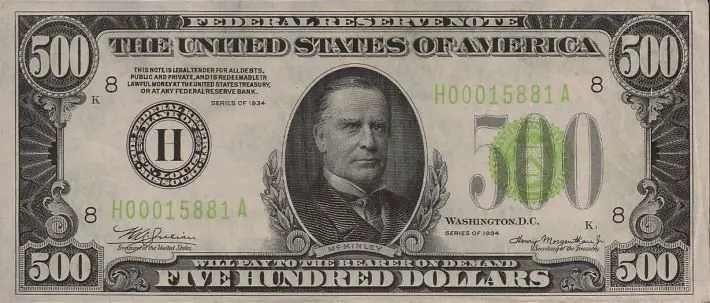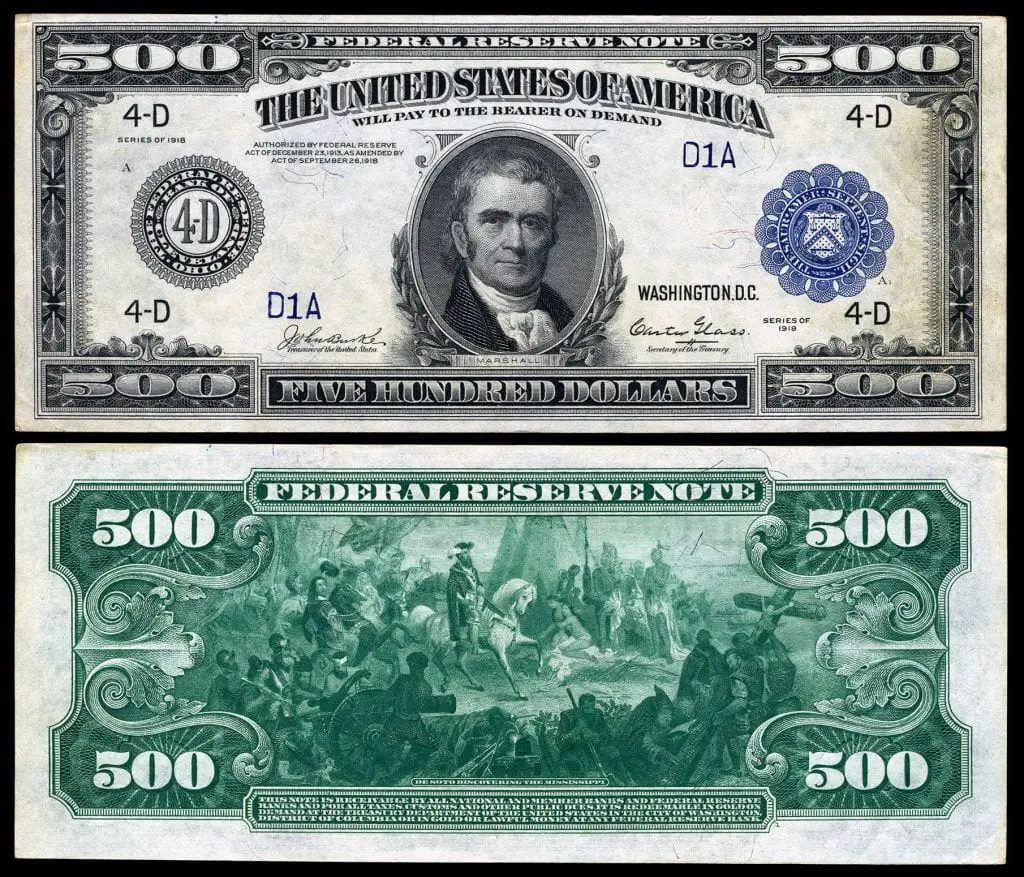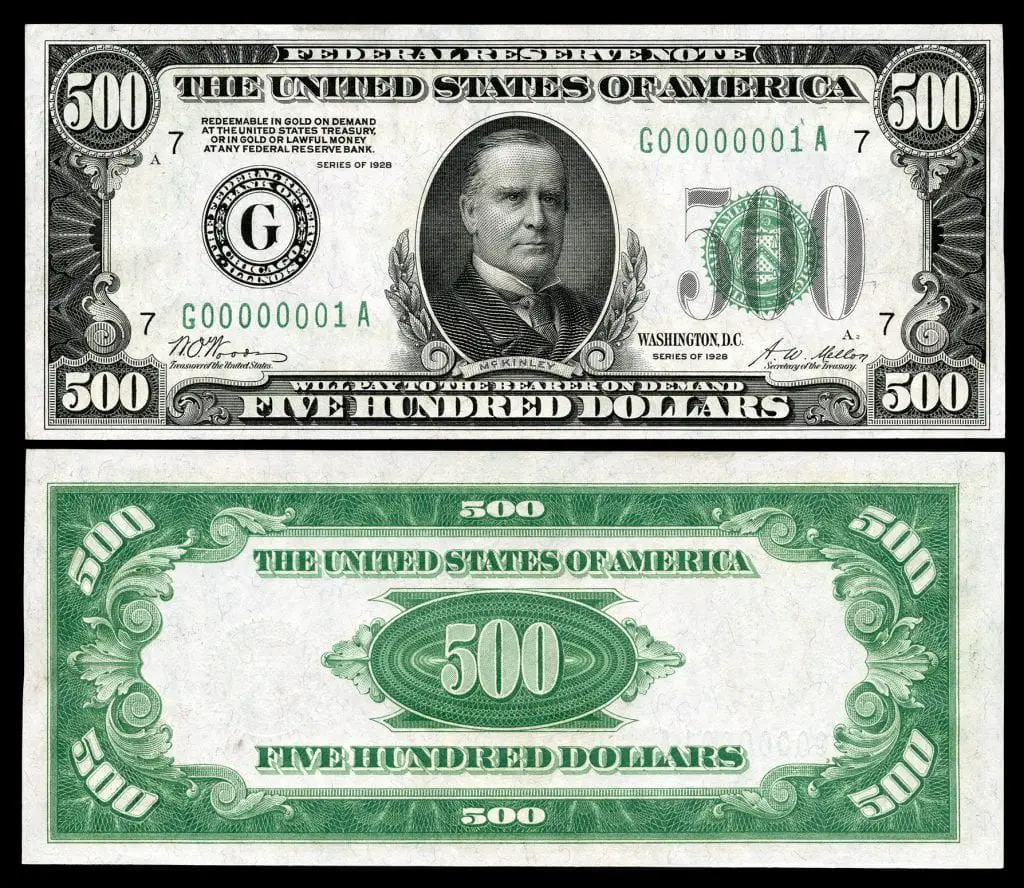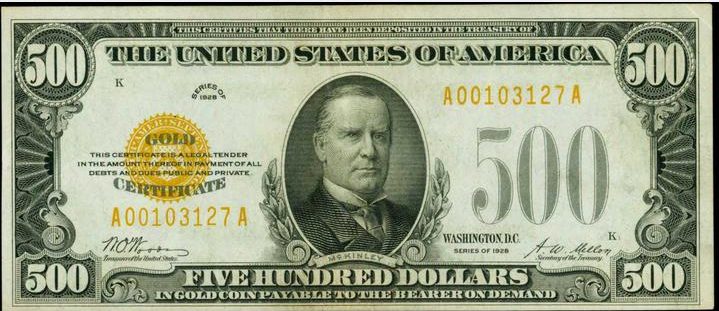Does a $500 dollar bill really exist?
The US currency system has gone through many changes over the years especially paper money.
These changes in the paper money were made due to many reasons. One of those reasons is to overcome the sophistication of thieves.
The other reasons include the lack of demands and the rising costs. Due to these changes, there were many denominations of paper currency which also includes the 500 dollar bill.
The US treasury stopped printing these bills many years ago but the $500 bill did not lose its worth even today. What is not merely a piece of paper but holds a lot of value and worth.
You’re right to be sceptical. A bill with that high of a denomination sounds crazy.
It’s almost inconceivable to picture carrying one piece of paper that can buy you 500 items from the dollar menu.
Contents
Is there a $500 dollar bill?
Yes, there is a $500 dollar bill and it’s completely real.

Though the bill has been uncirculated since 1945, it’s still legal tender.
If you had one, you could use it to buy your groceries.
But I wouldn’t recommend it. The actual value of a $500 bill is much larger than the face value of the bill.
This is common when it comes to large bills since they are rare bills.
The first federal reserve note worth $500 was printed in 1918. The next series of bills were printed between 1928 and 1934.
The History of the $500 Bill
The province of North Carolina issued the very first $500 note in May of 1780. After one year Virginia followed it by creating a $500 note of its own.
During the civil war and the war of 1812, these high denomination notes were issued as the confederate currency. Later the issuance of these 500-dollar notes was authorized by Congress.
This was the period of the federal banknote which begin in 1860. The federal reserve note issued the last $500 bill in 1934.
On the front of this $500 note, there was the picture of President William Mckinley.
The federal reserve system officially discontinued the high denomination bills which also includes the $500 bill in July of 1969. It was done because these bills got out of circulation.
However, these bills are still considered legal tender. As it is a collector’s item, so, if you have a 500 dollar bill then it is better for you to sell it to a collector than to make a purchase from these bills.
$500 bill rarity?
The $500 bill is one of the rarest bills in circulation today. Produced by the Federal Reserve, it has been out of circulation for decades and is considered to be a collector’s item.
The 500 note, which was last printed in 1945, was originally circulated widely as part of normal currency usage.
However, as time went on and financial trends shifted away from large-denomination bills like the $500, its use diminished and eventually led to it being taken out of production entirely.
Today, these rare bills have become highly sought after by collectors due to their scarcity and historical value.
Due to advances in technology such as ATMs and debit cards taking over transactions that once required large amounts of cash, many financial institutions no longer carry or accept these high-value notes.
Who is on the $500 dollar bill?
William McKinley is the president of the $500 dollar bill.
But, as I mentioned, there are two series of five hundred dollar notes. John James Marshall, the fourth Chief Justice of the United States, is on the 1918 series of the $500 dollar bill.
William McKinley is on the 1928-1934 series.
Light Green vs Dark Green
The US paper national currency is ever-changing, and two of the newest additions are the light green and dark green bills.
These updated designs were released in 2014 to replace their predecessor, the Series 1934 Federal Reserve Note.
In addition to a new look, each of these notes has various security features that make them difficult to counterfeit. The light green $500 note includes a portrait watermark of President William McKinley visible from both sides when held up to a light.
Additionally, there is an embedded security thread with “USA 500” appearing when held up to ultraviolet light along with color-shifting ink on the number 500 in the lower right corner changing from copper to green when tilted at an angle.
$500 Bill Series 1918 Blue Seal
The front of this series bill is adorned with the face of John James Marshall.
He was the Chief Justice from 1801 to 1835. This makes him the longest-serving Chief Justice. Fun fact: he was also classmates with the future president James Monroe.
The backside of the bill depicts an image of de Soto discovering the Mississippi.

$500 Bill Series 1928-1934 Green Seal
This series of bill actually depicts a president. The 25th president of the United States, William McKinley is on the $500 dollar bill.
The backside of the bill depicts “500 hundred dollars” as shown below:

What is the fancy serial number on the $500 bills?
The $500 note is one of the most desired denominations for collectors and investors alike. The bill itself holds an intriguing history, with some examples having a unique serial number that makes them even more valuable.
These ‘fancy’ serial numbers can be found on all denominations of US paper currency, but the $500 note has some of the most sought-after fancy serials out there.
Fancy serial numbers are those which have a repeating or low number pattern in their make-up, such as 00000001 or 12345678.
There are also super repeaters and radars which are even rarer; these feature two sets of matching numbers (such as 12121212 or 88888888).
Can I still get a five hundred dollar bill from the bank?
Though the $500 dollar bill is still considered legal tender, you won’t get one at the bank.
Since 1969, the $500 bill has been officially discontinued according to the Federal Reserve high-denomination bills.
This included the $500 dollar bill, the $1,000 dollar bill, the $5,000 dollar bill, and the $10,000 dollar bill.
Whenever a bank receives one of those bills, they’re instructed to send it in for destruction.
Of course, if you bring a $500 dollar bill to the bank to deposit, they’ll honor the value but you’ll lose the bill.
Why did they stop making these bills?
Initially designed to ensure faster high-denomination transactions between banks and account holders, the Federal Government developed the $500 bill (along with other high denomination bills).
However, these have fallen out of circulation and are no longer printed due to low levels of use, and the ease of counterfeiting increasing with time.
What is a $500 dollar bill worth?
As the $500 bill is a collector’s item. The worth of any collector’s item is determined by a number of factors.
These factors include the condition of the item and its rarity. So, the worth of a $500 bill is determined by the same factors.
The most commonly used $500 bill is that which was issued in 1934 having the picture of McKinley.
At that time over 900,000 of these notes were printed. Out of those 900,000, it is believed that 75,000 of those notes are still in circulation today and are available to collectors.
These bills are worth between $600 to $1500. Their average worth can be 40% premium to the face of bill value.

However, they can be of much more worth. The $500 bill that was issued in 1928 has the most value and worth.
This five hundred dollar bill has the star symbol at the end of the eight digits a serial number of the note.
This star symbol boosts its worth. It has more worth just because of its rarity. Its worth is more than $10,000.
You should not use it to buy your groceries or something like that, as the worth of this bill is far more than its face value.
Because of the rarity of a $500 dollar bill, its real value is much greater than its face value.
The value of a collector’s item is really whatever a collector is willing to pay for it. A bill in good condition is worth more than one in bad condition.
The 1934 $500 dollar bill that depicts William McKinley is the most common series, which means it has the least value. Even still, these bills are worth between $600 and $1,500 depending on their condition.
The rarer, 1918 $500 dollar bill is worth considerably more – between $5000 and $10,000 depending on condition.
How do I see if my note has folds?
When you’re checking the condition of a 500 dollar bill, it’s important to look for folds. Folds can be an indication that your note is in poor condition.
Knowing how to assess whether or not your paper money has folds is essential if you’re trying to determine its worth and value.
The first thing you should do when looking for folds is use good lighting. A bright light source will bring out any creases or wrinkles in the paper, making them easier to spot.
You’ll want to gently hold the bank note up and slowly turn it around so that all sides are visible – this will help ensure that no fold goes unnoticed. If you see any signs of folding along the edges or corners, chances are your note has been folded at some point before.
Depending on how severe they are, these folds may decrease the value of your note significantly.
Where can I buy a $500 dollar bill?
Unfortunately, you won’t probably find a “$500 dollar bill for sale” sign at your local pawn shop.
If you’re looking to buy one of these five hundred dollar bills your best bet is to contact several online dealers to see if they have any for sale.
You can also try looking on eBay.
However, it’s definitely riskier to buy a $500 dollar bill from eBay than from a trusted and certified dealer.
Helpful Video
In a Nutshell
While not as rare as higher-tier bills, the $500 bill is still 100% legal U.S. government tender.
If you’re able to locate a rare/older series of the $500 bill, its value may be 20x its actual denomination.
While these bills were made to create faster, more accurate transactions between banks and customers, they were rarely used and eventually fell out of circulation and production.
These aren’t the only high-tier bills.
There’s a $1,000, $5,000, $10,000, and even a $100,000 bill—to know more about those, check out our other guides on quite literal old money.

For less than 5 minutes of your time, earn yourself a random stock whose value is anywhere between $5.00 and $200. It is possible through an investing app called Robinhood.